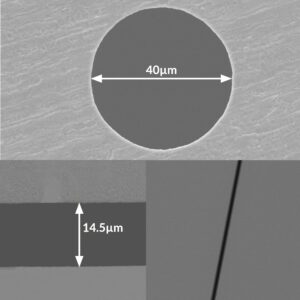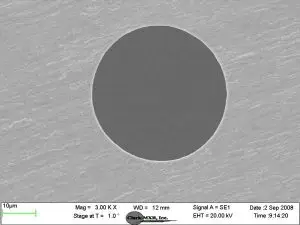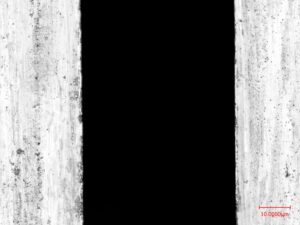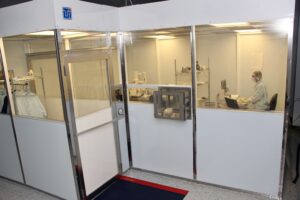
THE CHALLENGE
Manufacturers of analytical and diagnostic instrumentation have ongoing pressures to reduce costs. Use of ultrafast laser micromachining processing methods, by Clark-MXR, has improved customer’s bottom lines by providing new, groundbreaking capability for producing microscopic machined features on engineered components. Clark-MXR’s leading edge laser micromachining technology coupled with micromanufacturing expertise, cleanroom inspection and packaging capabilities offer far reaching value propositions for customers.
Optical, X-Ray and electron beam-based instruments, such as spectrometers, electron microscopes and X-Ray tools are dependent, in part, on high precision internal componentry that enable precision energy (light, X-Ray or electron) beam shaping and routing inside the systems. Some of these components are termed “Apertures” as they allow the passage of the energy beams through a hole or slit in a thin metal component. Hole and slit feature sizes can start as low as 2-5 microns in 25-50 micron-thick materials like tantalum or molybdenum.
Feature cut quality is of paramount importance when directing or managing the passage of an ion beam or electro-magnetic radiation. Excellent edge quality (i.e., no burrs or voids) reduces undesirable interference effects from dispersion/diffraction of energy at the aperture edges. Additionally, consistently high edge quality results in higher precision considerations for internal beam routing design, while offering longer-lived components. Rough edges “wear” over time due to thermal fatigue induced by minute concentrations of diffracted energy created in small burrs or voids (<1.0 micron).

40-micron aperture machined in 300-series black-oxidized stainless steel

50-micron wide spectrometer slit machined in molybdenum. No post-processing
Typically, laser machining companies process, inspect, bulk bag, and ship apertures to clients; leaving end users with the job of opening shipment packages, cleaning parts, re-inspecting them, and delivering them to the manufacturing floor which are typically cleanroom environments. With such delicate parts and added handling, end users can also experience yield fallout when parts are accidently damaged during many handling steps.
THE SOLUTION
In laser micromachining applications, laser pulse induced heat diffusion is a major culprit contributing to less than satisfactory results. Ultrafast laser machining eliminates negative effects of heat diffusion and allows apertures/slits to be machined with burr/void-free results. Clark-MXR’s Ultrafast Laser Micromachining Handbook is a widely accepted resource for an in depth look into the science of ultrashort pulse (femtosecond) laser micromachining. (http://cmxr.com/resources/).
In addition to state-of-the-art ultrafast laser micromachining, Clark-MXR’s facilities are uniquely resourced with high-level assembly expertise, cleanroom inspection equipment, and packaging capability allowing the supply of factory floor-ready products. Customers are able to bypass cleaning and inspection procedures and work with more customized packaging approaches to remove yield fallout on the manufacturing floor resulting in greater efficiencies thus higher profits.

Class-100 cleanroom for critical environment inspection and packaging

Packaged solution ready for end-customer/inventory
